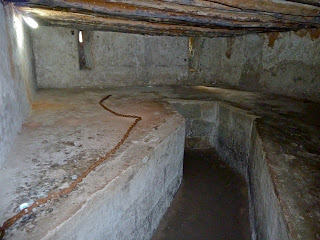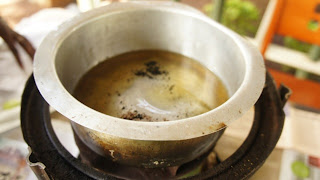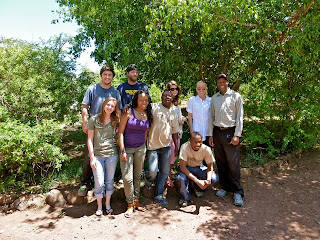For my fourth weekend in Tanzania a couple of friends and I decided to organize a small trip to Zanzibar. We decided that Easter weekend, which happened to be a 5 day weekend (an extra political holiday happened to fit into it as well), would be the perfect opportunity to travel down. As flying was to expensive we decided to take the ferry which is much cheaper but takes a while longer. We departed on Friday for Stonetown on Zanzibar to see the old site of the slave trade and the meeting point of three religions (Hindu, Muslim, Christian).
A memorial statue at the location of the old Stone town slave market. The statue was made by a Swedish sculptor and chains that were actually used to bind slaves are used in the statue binding the figures together. I hopped in to share a moment of silence.
After seeing the statue we took a shore walk underground to see the slave chambers where the slaves, fresh from the mainland (Tanganyika), were kept prior to being sold at the slave market. Upon entering the cool and damp chamber we were shocked to see the conditions. about 70 people would be forced into two chambers. The thing that appears to be a walkway is actually the bathroom.
After several days in these cramped, disgusting conditions, the people who survived would be considered the strongest slaves and be sold for the highest price. . .
After quite a somber morning start we headed to a different kind of market. The smells of spices filled our nostrils as we entered the Darajani Bazaar.
The spice section of the market was filled with both a ridiculous amount and selection of spices. From Cardamom to Coriander and Cloves to Saffron there wasn’t a color or taste that wasn’t represented. While it appears to be well priced these small quantities allow for some of these spices to be more expensive than gold per weight.
After spices we travelled into other sections of the Bazaar which has a wing for fish and seafood and a wing for livestock. Everything is pretty primitive and definitely not sterile but that doesn’t bother the locals.
After leaving the Bazaar, Elvis our tour guide, walked us through the winding streets of stone town with its towering houses looming over you on each side, keeping out much of the sunlight. The architecture of the city varies widely with the neighbor hoods as the Hindu and Muslim streets are very narrow while the Christian/Western side of town has wide streets.
Walking through the maze of streets that is Stone Town we stumbled upon a square buzzing with local activity and stopped for a cup of local Zanzibari Coffee. Steaming hot, it had quite a distinct but delicious and strong taste and of course it was nice to share some more local culture.
Another vibrant aspect of Zanzibar that caught our eyes was the famous ornately carved doors. While the styles differ between Hinduism and Islamic doors their beauty does not. On the Left: The Islamic door Square and brightly colored made to keep out evil spirits from the homes. Center & Right: A hindu door arched/circular and equipped with several spikes. A tradition brought straight form India where these spikes are used to keep thieves on elephants from breaking into houses.
Our last stop on the tour was one of Stone Town’s main attractions, the House of Wonders. Built in the 19th century by the Sheik of Zanzibar it is now the National Museum as well as being the tallest building in all of Zanzibar. It houses cultural items and much of the history of Zanzibar even before liberation in 1961.
An amazing picture of a 19th century ivory warehouse in London. It was hard, and sad to imagine the sheer number of elephants that we’re killed to get the amount of ivory seen here.
Under the picture was an authentic Elephant tusk about two meters long and completely oxidized with age.
Probably the scariest and oldest thing in the entire museum... was not a museum piece but rather the museums fire extinguisher which looked older than the building itself.


















































